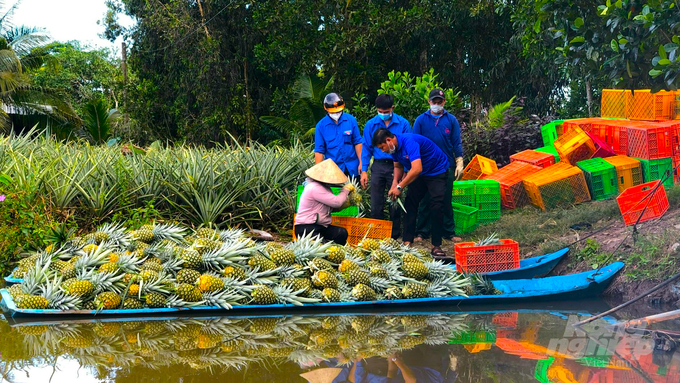Hoa Tien land (Vi Thanh town, Hau Giang) has long been naturally contaminated with alum, saline and plant cocoon. The farmers live mainly from pineapple, sugar cane and melaleuca trees. But the price of sugar cane is precarious, and Melaleuca is planted for almost ten years until harvest. Only pineapple is the “salvation” for farmers on difficult land.
Typically, Mr. Le Thanh Nghiep’s family in Vi Thang hamlet had losses many times because of sugar cane cultivation, so they switched to pineapple. Till now, with more than 10 years of pineapple growing experience, Mr. Nghiep is a successful person who knows how to treat the fruit in the wrong season and sell it at a high price.

Farmers who grow pineapples in Hau Giang always sell the fruit at a high price in the off-season. Picture: Ho Thao.
Mr. Nghiep said the pineapple variety selected by the family is Queen, with the characteristics of large fruit, short stalk, slightly deep eye socket, small pit, dark yellow flesh, low fiber, low water, crispy and sweet taste. Nghiep’s pineapple garden from planting to 12 months, the trees begin to bear fruit, the average fruit weight is 1.5 – 2 kg, the average yield is 20 tons/ha.
According to Mr. Nghiep, the family’s financial situation was initially limited, so he borrowed 60 million dong from the bank as capital. Under the motto of not feeding too long, he hires Mr. Nghiep and his wife to get money to repair the pineapple field. When the pineapple field developed well, Mr. Nghiep started cultivating the crops.
“In my experience, the price of pineapple is highest in the months of June, July, September and November, so farmers harvest in these months to make money,” Nghiep shared.
Mr Nghiep added that the most important phase is tillage. If a lot of weeds grow on the clumps, the rent for the weeders is double the initial amount of money for the tillage. Next, Mr. Nghiep selected pineapple varieties for large, long, disease-free fruit and few diebacks.
“Scent growers should visit their fields regularly if they spot diseased plants, rather than trying to save trees, farmers should uproot them and plant new ones with different trees. Because farmers’ money to buy sprays is many times more expensive than a pineapple seedling,” Nghiep said.

Cau Duc pineapples are dark yellow in color when ripe, have large fruits, little water and a sweet taste. Picture: Ho Thao.
Mr Nghiep further revealed that he used organic fertilizers in combination with inorganic fertilizers at a ratio of 7/3 to reduce input costs. By using compost, Mr. Nghiep’s pineapple garden is not only cost-saving but also still green, has a large fruit rate and is productive. Thanks to this, Mr. Nghiep’s 2-hectare pineapple field still has a profit of nearly VND 200 million after all expenses are deducted.
Not only is he good at producing, but Mr. Nghiep is willing to share his experience with the villagers so they can follow him and be successful.
Ms. Doan Thi Suong, who lives in the same area, said excitedly, “My family just harvested 15 pineapples (1 worker = 1,000m2), about 30 tons of fruit, traders come to buy in the field for 10,000 VND/fruit ( first class group). After deducting all expenses, I pocketed about 150 million Dong.
Ms. Suong shared that pineapple is easy to grow, grows well in acidic, acidic soil, and has a low cost. On average, Ms. Suong planted about 2,000 seedlings on the land, each 6-7 cm apart. After planting the tree for a month, Ms. Suong began pouring fertilizer to encourage root development. After that, Ms. Suong regularly watered the plants with organic fertilizer once a month. After fertilizing 12 times, Ms. Suong’s pineapple field began to bear fruit.
According to Ms. Suong’s calculations, the capital invested in a pineapple land costs only about VND 5-8 million from planting to harvesting, while selling at price and profit is VND 15 million. Therefore, next year, Ms. Suong plans to expand the pineapple planting area by about 1 ha and further work the pineapple field to produce off-season fruit.

5 acres of pineapple field from Mr. Nghiep’s family. Picture: Ho Thao.
“In the off-season, pineapples are sold at VND10,000/fruit or more, merchants buy fewer goods, so we farmers can make a profit,” Ms. Suong said.
According to Ms. Suong, today pineapple is not only consumed fresh, but also processed into many other products such as pineapple juice, dried pineapple, sweets, jam, drinks, etc. Dishes made from pineapple such as perch sour soup, fried bacon with pineapple, stewed fish with pineapple …
Mr. Truong Huu Vinh, chairman of Hoa Tien Township Farmers’ Association, said that about three years ago, due to the effects of climate change, rising water surface affected the yield of some local crops. The pineapple tree is still growing well, the price is stable, so the community farmers’ association has provided technical guidance on how to convert to pineapple to improve household economy. Also, the community has established two cooperatives to further develop the brand name Cau Duc Pineapple, Hoa Tien Commune in the market.
According to the Hau Giang Ministry of Agriculture and Rural Development, the pineapple is one of the four most important crops in the province. In 2022, the sown area of pineapple throughout the province is more than 3,000 hectares, the production is estimated at more than 37,000 tons; By 2023, the province’s production is expected to increase to over 48,000 tons.
According to the planning plan of Hau Giang Province, Hoa Tien Township plans to become a pineapple-growing area covering 100% of the area. To date, about 80% of the community area has been converted from other trees into clusters. Looking to the future, the province continues to develop the Cau Duc pineapple brand name to improve competitiveness, create economic and social value, and play an important role in preserving local identity.

